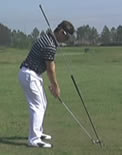Furrows redux
It's time for Jack Nicklaus's Memorial Tournament, which also means the furrows are back.
In 2006, the furrows contributed to a drop in sand saves from 49.1% to 43.8% (stats courtesy of A Walk in the Park).
However, it seems Nicklaus didn't want to incur the same ire from players this year as he did last, so, "....[Nicklaus's] intent was to restore the penalty of hitting into a bunker... some players said the size of the furrows took skill out of the sand shot.
"This year, we're consistent with the size, and we really don't think the players are going to find it to be a big hazard," Nicklaus said. "It puts a little ripple in the sand. Can you get a bad lie? Yeah. You'll be pretty hard-pressed, though."
Nicklaus gave them a test over the weekend, hitting six bunker shots.
"One was a long bunker shot, and other five I hit within a foot," he said. "I said, 'Well, if I can do that, I think it's going to be pretty easy for those guys.' I don't think that will be an issue this year, frankly."
The buzz word for the bunkers is called "rough raking," perhaps to get the word "furrow" out of the vocabulary this week. But if the penalty won't be severe, why use any special rake at all?"
(Quote courtesy of PGA.com)
So it would seem that in 2006, the furrows had their intended effect. In fact, Carl Pettersson, last year's winner, hit into only one bunker all week.
This is, after all, Jack, and if Jack wants to loose Bengal tigers on the course during tournament play (obviously he'd spare the pro-am) most players would be happy to accept the danger for their chance to win Jack's tournament.
It probably has to do with the fact that Jack, as a golfer and pillar of the community, is not a rebel, and probably, above all else, now that he's retired, needs to be liked by those he respects most--the players in his tournament. His legacy is his 18 majors, not his furrows. So if using shortened teeth in his rakes nets him a few more, "Thanks, Mr. Nicklaus--your tournament's the best," from the likes of, say, Tiger Woods, then he's probably only too happy to oblige.














